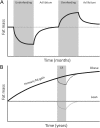Clinical review: Regulation of food intake, energy balance, and body fat mass: implications for the pathogenesis and treatment of obesity
- PMID: 22238401
- PMCID: PMC3319208
- DOI: 10.1210/jc.2011-2525
Clinical review: Regulation of food intake, energy balance, and body fat mass: implications for the pathogenesis and treatment of obesity
Abstract
Context: Obesity has emerged as one of the leading medical challenges of the 21st century. The resistance of this disorder to effective, long-term treatment can be traced to the fact that body fat stores are subject to homeostatic regulation in obese individuals, just as in lean individuals. Because the growing obesity epidemic is linked to a substantial increase in daily energy intake, a key priority is to delineate how mechanisms governing food intake and body fat content are altered in an obesogenic environment.
Evidence acquisition: We considered all relevant published research and cited references that represented the highest quality evidence available. Where space permitted, primary references were cited.
Evidence synthesis: The increase of energy intake that has fueled the U.S. obesity epidemic is linked to greater availability of highly rewarding/palatable and energy-dense food. Obesity occurs in genetically susceptible individuals and involves the biological defense of an elevated body fat mass, which may result in part from interactions between brain reward and homeostatic circuits. Inflammatory signaling, accumulation of lipid metabolites, or other mechanisms that impair hypothalamic neurons may also contribute to the development of obesity and offer a plausible mechanism to explain the biological defense of elevated body fat mass.
Conclusions: Despite steady research progress, mechanisms underlying the resistance to fat loss once obesity is established remain incompletely understood. Breakthroughs in this area may be required for the development of effective new obesity prevention and treatment strategies.
Figures



References
-
- Omran AR. 1971. The epidemiologic transition. A theory of the epidemiology of population change. Milbank Mem Fund Q 49:509–538 - PubMed
-
- Flegal KM, Graubard BI, Williamson DF, Gail MH. 2007. Cause-specific excess deaths associated with underweight, overweight, and obesity. JAMA 298:2028–2037 - PubMed

